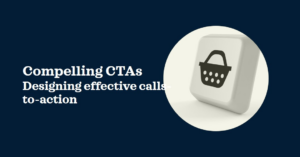Introduction:
In the digital realm, Calls-to-Action (CTAs) serve as powerful prompts that guide users towards desired actions, whether it’s making a purchase, subscribing to a newsletter, or downloading a resource. Effective CTAs are not just buttons or links—they’re strategic elements carefully crafted to capture attention, evoke emotion, and drive conversions. In this guide, we explore the principles and best practices for designing compelling CTAs that inspire action and maximize engagement.

1. Clarity and Conciseness:
The foundation of an effective CTA is clarity and conciseness. Clearly communicate the desired action using concise and straightforward language that leaves no room for ambiguity. Use action-oriented verbs such as “Buy,” “Subscribe,” “Download,” or “Sign Up” to clearly indicate what users should do next. Avoid jargon or vague phrases that may confuse or deter users from taking action.
2. Standout Design:
A visually appealing design is essential for grabbing users’ attention and making CTAs stand out on the page. Use contrasting colors, bold fonts, and prominent placement to draw attention to the CTA button or link. Ensure that CTAs are easily recognizable and distinguishable from surrounding content to avoid any confusion about their purpose. Experiment with different design elements and layouts to find what works best for your audience and objectives.
3. Compelling Copywriting:
Compelling copywriting is key to persuading users to click on CTAs and take the desired action. Use persuasive language that speaks directly to the user’s needs, desires, and pain points. Highlight the benefits or value proposition of taking action to entice users and create a sense of urgency or FOMO (Fear of Missing Out) to encourage immediate action. Keep the copy short and to the point, focusing on conveying the most important information in a clear and compelling manner.
4. Strategic Placement:
Strategic placement of CTAs can significantly impact their effectiveness in driving conversions. Position CTAs prominently within the user’s field of view, ensuring they are easily accessible and visible without the need for scrolling. Place CTAs at key touchpoints throughout the user journey, such as at the end of blog posts, on product pages, or during checkout, to prompt users to take action when they are most engaged or ready to convert.
5. Mobile Optimization:
With the increasing prevalence of mobile browsing, it’s crucial to optimize CTAs for mobile devices to ensure a seamless user experience across all platforms. Use responsive design principles to ensure that CTAs are mobile-friendly and accessible on smaller screens. Optimize button sizes, spacing, and placement to accommodate touch gestures and make it easy for users to tap on CTAs without any difficulty.
6. A/B Testing and Optimization:
Continuous testing and optimization are essential for maximizing the effectiveness of CTAs over time. Conduct A/B tests to compare different variations of CTAs, such as different colors, copy, or placements, to determine which performs best. Analyze user engagement metrics and conversion rates to identify areas for improvement and refine CTAs based on insights and feedback. By iteratively testing and optimizing CTAs, you can fine-tune your approach and drive better results over time.
Conclusion:
Designing effective Calls-to-Action (CTAs) is both an art and a science, requiring careful consideration of design, copywriting, placement, and optimization. By prioritizing clarity and conciseness, standout design, compelling copywriting, strategic placement, mobile optimization, and continuous testing and optimization, you can create CTAs that inspire action and drive conversions effectively.
As you design CTAs for your website or marketing campaigns, remember to put yourself in the user’s shoes and consider what would motivate them to take action. By aligning CTAs with user needs, desires, and behaviors, you can create compelling prompts that resonate with your audience and lead to meaningful engagement and conversions.



